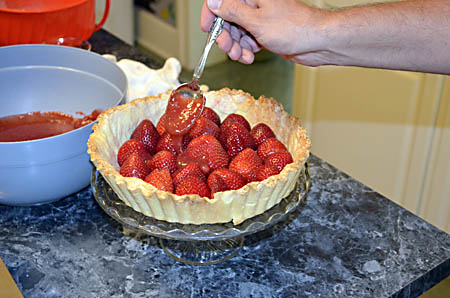Bullseye Cheesecake
Source: Maida Heatter's Cakes (Andrews & McMeel Publishing, 2011 ed.), pg. 132.
This is one of Maida Heatter's most famous recipes. The size of the pan is important - it must be a one-piece 8 x 3 pan.
The only area where I strayed from Maida's instructions was for the crust. She says to pat the crumbs onto the cheesecake after it has baked. I have tried this before and it is messy and the crust is not as good. So, I used my basic recipe for a cheesecake crust and made it in the pan before adding the batter.
32 oz. cream cheese (Use Philadelphia brand - others do not all work the same - preferably at room temperature)
1/4 cup sour cream
1 tsp. vanilla extract
1/4 tsp. almond extract
1/4 tsp. salt
4 eggs
2/3 cup granulated sugar
2/3 cup dark brown sugar, firmly packed
1 tsp. powdered (not granular) instant coffee
2 tsp. unsweetened cocoa powder
For the crust:
About 1/4 cup graham cracker crumbs or crumbs made from Amaretti or any other crisp cookies (to be used after the cake has baked) (OR use this recipe instead)
 |
| Adjust a rack 1/3 from the bottom of the oven and preheat to 350. Butter an 8x3 inch one-piece cheesecake pan all the way to the rim. You will also need a larger pan to make a water bath. Set aside. |
 |
| Beat the cream cheese until it is soft and smooth (it should be at room temperature). |
 |
| Beat in the sour cream. |
 |
| Add the almond and vanilla extract. |
 |
| Add the salt. |
 |
| Add the eggs, one at a time, scraping the bowl as necessary to insure that the mixture is smooth. |
 |
| Remove the bowl from the mixer stand and divide the mixture into 2 bowls - you will have about 3 cups each. |
 |
| Add the regular sugar to one bowl... |
 |
| Add the brown sugar to the other bowl. |
 |
| Stir in the sugar with a rubber spatula until it has dissolved. Do the same for the other bowl as well. |
 |
| To the dark mixture, add the instant coffee and the cocoa. Stir. |
 |
| You will now pour the batter into the pan in 4 separate additions. Pour half of one mixture (it does not matter which you start with) into the buttered pan. |
 |
| Now pour half of the other mixture in the center. The second mixture will expand but will stop before it reaches the edge. Really cool, right? |
 |
| Add the remaining portion of the first mixture you used, again right in the center. |
 |
| Add the remaining portion of the last mixture. See the bullseye forming... |
 |



































